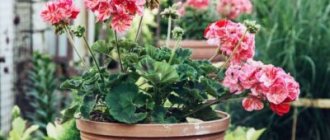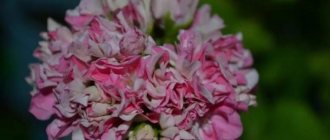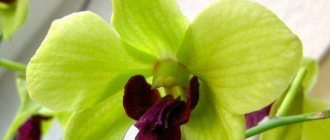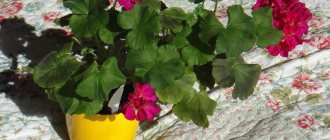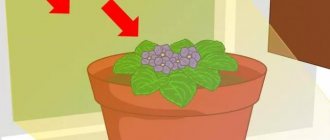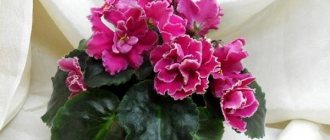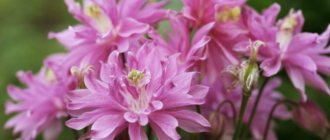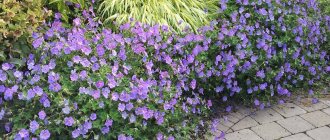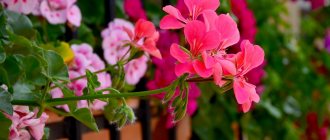History of origin
Initially, India was considered the birthplace of pelargonium, but this statement was erroneous. And all because it was delivered on European ships that sailed to the shores of India. As it turns out, South Africa is the true place where pelargonium grows . There, at the Cape of Good Hope, sailors bought exotic plants for breeders and botanists. 80% of the known pelargonium species were found in this part of the world.
In 1951, an association of amateurs and breeders called the British Pelargonium and Geranium Society was created in England, under the leadership of John Cross. Thanks to this, a new wave of popularity for pelargoniums began, and interest in marvelous flowers was revived, which continues today.
Reference. More than 100 million plants are grown and sold worldwide each year.
Description
Russian breeder Yulia Gonchar gave the world many varieties of geranium.
The plant attracts with its rich color
Unlike other varieties, representatives of the YUG group have a compact size and beautiful flowering.
A brief history of the appearance of flowers of the YUG group
India has long been considered the birthplace of pelargoniums, but only recently have scientists been able to establish the exact origin of the plant. It originally appeared in South America.
Active selection began in 1951 in England. Amateurs and experienced flower growers grew new varieties, achieving improved flower characteristics.
Yulia Gonchar (YUG) was no exception. She wanted to get compact geraniums that would have large inflorescences. Over time, the breeder's work was successful, and she created many new plants.
For example, pelargonium SOUTH Aksinya has double inflorescences of a delicate red color with a barely noticeable white center. The small size of the specimens allows them to be kept in apartments and tiny rooms. The dwarf size does not make pelargonium unattractive; on the contrary, at such a height the plants’ inflorescences look impressive.
Appearance and varieties
Pelargonium is a perennial herbaceous or subshrub plant. The inflorescences have an irregular shape. Petals are white, pink, and shades of red.
The fruit is a seed capsule with sepals. The foliage is green, covered with small fibers. The leaves have a pleasant smell.
Experts in the field of botany count over 250 varieties of pelargonium, which are divided into 30 groups. Main groups :
- zonal;
- ivy-leaved;
- fragrant;
- royal;
- angels;
- unique.
Greenhouse farms in Great Britain, Belgium, Holland, and Russia are engaged in the selection of pelargonium. I would like to highlight the domestic amateur breeder Yulia Gonchar. She has the following varieties :
- Pelargonium South-Aksinya.
- South Alexandra.
- South Anisa.
- South-Giselle.
- South Yesenia.
- South Deya.
- South-Tamil.
- South Ireland.
- South Siberia.
- Yug-Eter and others.
Conditions of detention
The culture is photophilous. The best places for placement are southern and eastern window sills. For the bush to fully develop and form a neat shape, it should be periodically rotated relative to the window: this way, all its sides will receive an equal amount of light. If there is not enough lighting, the gardener will know this by the yellowness of the foliage.
In this case, you need to regularly ventilate the room. Fresh air will allow the crop to maintain a vigorous appearance, bright leaves and lush flowers. Air humidity is not a very important factor for SOUTH pelargonium. However, if you want to provide the most comfortable conditions for your green pet, keep this indicator at 60%. There is no need to spray the plants.
In spring and summer, the optimal temperature will be from 20 to 23°. The plant does not tolerate heat very well. In winter the flower rests. During this period, it is better to provide it with a temperature regime of 15 to 17°.
Description and photos of species of Yu. Gonchar’s own selection
Below is a detailed description and photo of the varieties Shukar, Varvara Krasa, Nina, Kamalia.
Nina
Plants of the species are zonal, dwarf in size . Flowers with densely double petals, pale pink with a soft purple tint. A lush compact bush easily forms on its own. The stem and peduncles are dense, fleshy, directed upward. The inflorescences are shaped like roses. The foliage color is golden with a brown edge.
This variety of pelargonium got its name in honor of grandmother Yulia Gonchar. The price of a rooted cutting is 1000-1500 rubles.
Shukar
This species also belongs to the zonal species. Standard size, requires shaping. Inflorescences are scattered in different directions. Shades: cherry, scarlet, dark red with tints. The texture of the flowers is semi-double and simple, large in size. The shape of the petals is slightly elongated. The name "Shukar" translated from the Gypsy language means "beauty" . The price of a rooted cutting varies from 1000-1200 rubles.
Varvara Krasa
An upright zonal plant, dwarf in size. The bush is dense, dense, easy to form, and has regular growth. The flowers are large, double, light pink. In the sun it takes on a deeper pink hue. Pelargonium blooms profusely and for a long time. You can buy rooted cuttings for 500-700 rubles apiece.
Kamalia
Zonal flower, dwarf size. The bush is branched, the foliage is green. The inflorescences have an original shape, slightly shabby. The color is soft pink, gradually turning to rich. The texture of the flowers is terry. The variety is distinguished by long-lasting flowering, even in winter. The cost of one cutting is 700-1000 rubles.
What kind of flowers is this?
Pelargoniums of all varieties belong to the family called Geraniaceae, which unites several hundred different plant species - herbaceous, subshrubs.
Original colors, beautiful leaves, low maintenance requirements - all this is about the varieties of the YUG group
Pelargonium flowers are inflorescences in the form of umbrellas, which are characterized by a variety of shades: from snow-white to purple, burgundy and red. In this case, the colors can be either monochromatic or combined.
For your information! Pelargonium leaves are simple green, but there are also variegated varieties.
Brief description and history of selection
Amateur flower growers would never have been able to plant these amazing pelargoniums if not for Yu. Gonchar. The abbreviation that can be seen in the names of varieties is the initials of a breeder from the Voronezh region. Gonchar developed rather compact pelargoniums, which are characterized by lush flowering.
Important! All varieties, except, perhaps, YUG-Shukar, do not need shaping.
How and where to plant?
The container for pelargonium is chosen to have a small diameter. Compact flower bushes will hold their shape better in them; flowering also directly depends on the size of the flowerpot . The plant refuses to bloom in large pots. Material for the container, preferably clay. A drainage layer of at least 2 cm thick is required.
- The plant should be placed in a pot carefully; the root system is fragile.
- Then carefully sprinkle it with earth without compacting it.
- Moisten the top a little with warm, settled water.
Lighting
You need a lot of light. The plant loves sun and bright light. Preference should be given to window sills on the south side. However, if there is poor ventilation, it may overheat, in which case you need to temporarily darken it. With a lack of sunlight, the leaves turn yellow and the lower ones dry out. For an evenly lush crown, the flower must be regularly turned to the sun, first on one side, then on the other.
The soil
For planting and replanting, the soil needs to be loose, breathable, and enriched with minerals. Soil for pelargonium can be purchased ready-made at garden stores . Or cook it yourself.
The composition of this soil mixture is: leaf soil, peat or compost humus, sand. All components must be in equal proportions.
For safety precautions, it is better to ignite the components of the mixture for 30 minutes. You can also add perlite as a soil loosener.
Growing pelargonium - features and secrets
Many flower lovers love pelargonium - a beautiful, unpretentious flower, easy to propagate and easy to care for. Pelargonium is popularly called geranium, although this is not entirely true. Geranium is a completely different flower that is frost-resistant and can be grown in one place for many years. But pelargonium is thermophilic, and can be kept in the garden only in the warm season. Growing pelargonium is not difficult even for a novice gardener, if you have an understanding of the characteristics of this flower.
growing pelargonium
What are the features of pelargonium?
This flower is considered to be in the geranium family. The flower was brought to Europe from Holland in the 18th century. It quickly gained popularity among flower growers. Breeders have managed to develop a large variety of pelargonium species. All varieties can be divided into six large groups: ampelous (ivy-leaved), English home large-flowered, garden, fragrant, variegated, succulent.
Moreover, ivy-leaved and garden varieties reproduce well by seeds and grow well in open ground, decorating flower arrangements.
Pelargonium - growing conditions
It can be grown at home in winter, and in the summer in the garden or directly in the ground or in pots, complementing the flowering composition.
- Temperature regime . Pelargonium is thermophilic, so before the first frost it needs to be moved indoors. The optimal home temperature in winter should be from 8 to 12 degrees. In summer, the plant requires moderate heat of 17-23 degrees. The plant is planted in the garden outdoors after threats of return frosts. At a temperature of about 12 degrees, pelargonium stops blooming. But high temperatures are also undesirable for the plant. The plant signals a low, uncomfortable temperature by turning the leaves red. When removing a flower from the garden in the fall, it is necessary to reduce the temperature and amount of water when watering so that the plant reduces its growth and does not become depleted in low light.
- Lighting . The plant is light-loving and with a lack of light it blooms weakly and becomes very elongated. Interestingly, when grown in the garden it tolerates direct sunlight very well, but at home the flower needs to be protected from the sun by shading the flower. However, with a lack of lighting, the plant begins to turn yellow, losing the lower leaves and exposing the stem, and blooms poorly. At home, it is necessary to turn the flower towards the light several times a week for its uniform development.
- The flower loves space, so there is no need to plant other plants close.
pelargonium - variety of species
- Watering . Pelargonium is a drought-resistant flower, but quickly becomes infected with fungal diseases. Therefore, when watering, it is better to underwater than to overwater. Therefore, they usually water the plant when the soil under it dries out, without allowing it to dry out completely. The leaves signal that the plant is overwatering: they become limp and drooping. If there is a lack of water in the soil, the leaves turn yellow, the edges dry out, and the plant stops blooming. Air humidity does not play a role in the life of pelargonium, so it does not need to be sprayed. Increased humidity can provoke fungal diseases.
- fertilizing with each watering, calculating the dose of fertilizer for the number of waterings. Or feed once a week until late autumn. If the soil under the plant is dry, you must first water it with regular water, and then add fertilizer. If you managed to create a low temperature in winter, then fertilizing is completely unnecessary. If the flower still grows a little, then fertilizing is carried out with a quarter of the required dose of fertilizer. 2-2.5 months before flowering, the plant should be fed with mineral fertilizers with a large amount of potassium. If symptoms of leaf chlorosis appear, be sure to include iron chelate and magnesium sulfate in the fertilizing.
- The soil . For beautiful flowering and a healthy plant, the soil must be fertile. The composition of the soil consists of a mixture in equal proportions of peat, sand, and garden soil. It is imperative to drain the stones. Do not forget to loosen the soil more often so that there is good air access to the roots, which will prevent them from rotting.
- Pot size . For pelargonium, the flower pot is selected according to the size of the root system. The plant grows much better and also blooms brighter and more abundantly in small containers. In large pots, the plant itself begins to actively develop to the detriment of flowering.
- To form a bush and quickly branch, it is recommended to pinch the growing tip around February or March.
pelargonium, growing conditions
Pelargonium propagation
The plant develops well within 2-5 years. Therefore, you need to propagate it by cuttings, which can be rooted from early spring to late autumn. Cuttings are taken from the tops 5-7 cm long only from healthy and strong plants. The lower leaves of the cutting are carefully removed and an oblique cut is made below the node, which needs to be dried and then placed in a container with water until the roots appear.
That's all about pelargonium. Following our useful tips, growing pelargonium will not cause you any problems or difficulties, and the plant will delight you with lush, beautiful flowers.
If you find an error, please select a piece of text and press Ctrl+Enter.
Conditions for growing indoor flowers
Pelargonium is an undemanding indoor flower . However, for a healthy and beautiful appearance, comfortable conditions are important for the plant.
- An indoor flower should be watered abundantly, but at the same time the water should not stagnate in the pot. Watering is needed abundantly, daily, especially in hot weather. In winter, you don’t need to water much, but you should not let the soil dry out completely. If watering is abundant, traces of gray rot appear on the leaves, and sometimes the stem rots, which can lead to the loss of the plant. If you water little, the flower withers, the leaves begin to turn yellow and dry out.
- Air humidity is not particularly important for pelargonium; on the contrary, excess moisture and stagnant air can cause fungal diseases of the flower. Spraying should not be done.
- In the warm season, the optimal temperature is +18 -22 C°. Sufficiently high air temperatures, especially indoors, will also negatively affect the plant.
- In winter, pelargonium is in a state of sleep. Plants should be moved to a room with a temperature of +12°C and regular ventilation. This could be a loggia, balcony, greenhouse. Watering should be sparse. Wintering lasts approximately from November to February. At the end of winter, pelargonium begins to gradually wake up.
- Replanting and pruning. These procedures should be performed annually, preferably in the spring, in mid-March. In order for the plant to have a lush appearance, it is necessary to trim the pieces. Perform this procedure only with a sharp knife diagonally. Broken parts of the plant may be affected by rot. And to enhance growth and branching, shoots are pinched.
- To ensure adequate nutrition, the flower needs to be fed and organic fertilizers applied. But it is important to dose the fertilizer and follow all the instructions indicated on the packaging:
- Feed “Mr. Color” Saintpaulia during or before flowering with 1 capful per 1 liter of water.
- "Gilea" - recommended concentration is 2 caps per 1 liter.
- “Fertimix” vermicompost for flowering plants, 3 caps per 1 liter, apply once every 10-14 days.
Important. Use only clean water at room temperature.
Adding nutrients is prohibited in hot weather. In this case, the plant will suffer stress.
- First, you should move it to a cool place.
- Next, be sure to water the flower, otherwise fertilizers may burn the roots.
Most of all, the plant needs additional nutrition in summer and spring. Therefore, you need to feed until the beginning of September, approximately once every 2 weeks . You should not feed a transplanted or just purchased plant; you need to wait at least 1 month. It is also not recommended to use mineral fertilizers for sick flowers with damaged root systems.
How to properly care?
- You need to moisten the soil regularly, but at the same time make sure that the water in the pot does not stagnate. In summer, watering once a week is sufficient. And in winter, you can further reduce watering - up to once a decade. The gardener will be informed of an excess of moisture by rotting rhizomes, leaves and stems.
- Pelargonium South has no special requirements for air humidity. But the plant will feel more comfortable at low humidity - approximately 60%. You should avoid spraying altogether.
- In the warm season, it is worth maintaining the temperature within 20-23 degrees above zero. You should not raise it higher, as the plant may simply be prohibited.
- In winter, Pelargonium goes into a dormant state. At this time, the temperature drops to 15-17 degrees. At the same time, no one canceled the ventilation. This period usually lasts from late November to February. At the beginning of spring, the plant begins to awaken.
- Pelargonium South needs to be pruned regularly in order for a beautiful bush to form. It is better to use sterile materials for this. It is also necessary to pinch out shoots that are too long so that they do not break under the weight of their weight.
- But there is no need to worry about replanting. The flower does not tolerate this procedure well. Therefore, it is better to change his place of residence no more than once every 2-3 years.
- It is necessary to fertilize during the period of active growth and flowering. To do this, you should use ready-made complexes, strictly adhering to the instructions and dosage.
Attention! In very hot weather there is no need to feed Pelargonium Yug.
Reproduction methods
Cuttings
At the end of flowering, the tops of the pelargonium are cut off. The top 3 leaves are left, the others are removed.- Sections must be treated with fungicide, ash or activated carbon. This is done so that the stem of the mother plant does not rot.
- Then the cuttings are placed in transparent glasses with drainage, coke fiber or coarse sand is placed in them, and liquid is poured in.
Another option is to place the cuttings in a container with water and, as they dry, it needs to be added.
Roots appear quite quickly, after 10-12 days . The temperature in the room must be maintained at least +20°C. After this, the rooted cuttings are planted in previously prepared soil in a permanent place, where they continue to develop.
Next, you can watch a video that talks about cuttings:
Dividing the bush
If the bush has grown, you can divide it. The best time for this is spring, when the plant is replanted and the soil is renewed.
- First of all, remove the flower from the pot and shake off excess soil.
- Then they carefully examine his kidneys.
- The area with healthy kidneys is separated and transplanted into another container.
Landing
It is better to choose a small clay container for planting. The dimensions of the pot have a direct connection with the formation of the bush and the abundance of flowering. In large containers the culture hardly blooms.
A drainage layer (about 2 cm) should be placed at the bottom The plant should be moved very carefully so as not to damage the delicate root system. You need to carefully cover the roots with soil without compacting them. Finally, you need to water the flower with clean warm water. Only settled or filtered liquid is suitable for irrigation
Diseases and harmful insects
Pelargonium is resistant to various diseases and pests . But they still occur:
- Gray mold is a disease that affects leaves. You need to fight it in the following way: remove damaged leaves, stop watering the plant, put it in the sun, spray it with an antifungal agent.
- Rot of the root collar of a flower develops with excess moisture. This phenomenon turns out to be detrimental to pelargonium.
- Rust appears as yellow spots on the bottom of the leaf.
Disease prevention is to treat plants with antifungal solutions before wintering. They are also sprayed with fungicide products, the drug “Doctor Foley” for fungi. The affected parts of the plant must be removed. Among insects, the main pests are whiteflies, aphids, mites, thrips, and mealybugs.
Advice. Before buying a flower, carefully inspect it; you can infect other healthy plants. They are treated with products with insectoacaricidal properties, for example “Doctor Foley” against parasites.
What other famous varieties of pelargonium are there? Read about Richard Hudson, Prince Gustav, April Snow, Star-shaped, Milfeed Rose, Australian Pink Rosebud, Anita, Rococo, Grandiflora, Red Pandora.
Growing pelargonium at home is not at all difficult . Especially if you follow the basic rules for caring for the plant. Then the flower will grow and smell fragrant for joy.
Varieties
The YUG group currently includes many varieties. They have different colors, and this allows collectors to show interest in new species. The shades of some varieties of pelargonium change during flowering. For example, like YUG Varvara-Kras’s pelargonium.
Geranium variety with double-colored petals
- SOUTH Shukar - rich burgundy color of the petals, size about 50 cm, requires the formation of a crown.
- SOUTH Jadwiga pelargonium - flowers are soft pink, do not require pruning, green leaves. Average height 40 cm.
- SOUTH Sakura - the name comes from the plant of the same name. The center of the flower is crimson, the rest is light pink. The leaves are serrated.
- Pelargonium Varvara-Krasa is a dwarf size, height does not exceed 30 cm. Double flowers are similar in shape to peonies. Color white-pink. Blooms for a long time.
- SOUTH Zlatoslava - Bright pink inflorescences. The leaves are green with a slight tint of gold.
- SOUTH Claudia - snow-white, double flowers, plant size is dwarf, crown formation is not required.
- SOUTH Princess Grace is an original variety. The white petals are edged with a dark pink border.
- Pelargonium SOUTH Ireland - flowers are white, sometimes greenish in the middle and outside of the petals. Does not require the formation of a bush.
- SOUTH Yesenia - pink flowers with reddish veins, the edges of the petals are pinkish-white.
- SOUTH Nina - golden foliage. The flowers are densely double, pale lilac-pink. The bush forms independently.
Pelargonium SOUTH Shukar needs the right conditions. The abundance of flowering and the lifespan of the flower depend on this.
Important! If you deviate from the recommendations, the geranium may stop blooming. Factors required to grow a flower:. Factors required to grow a flower:
Factors required to grow a flower:
- Illumination is diffused light; during the flowering period, the duration of daylight is at least 8 hours.
- Temperature – in the warm season – 23 °C, in the winter – 15 °C.
- Watering – during the flowering period, the plant is watered once a week, as stagnation of moisture leads to the development of gray rot. In winter, the amount of watering is reduced to once every 10 days. The humidity level is maintained at 60%. SOUTH Segal pelargonium and others do not need spraying.
- Fertilizing – during flowering, add a universal remedy for flowering plants once a week. The soil should be loose and nutritious.
- The size of the pot is 1 cm larger than the earthen ball.
- Pruning - dwarf varieties do not need to form stems; taller specimens can be pinched out in the spring. Transplantation is carried out once a year.
Varieties of indoor plants with names
Pelargonium PAC Viva Madeleine, Carolina and other varieties
This group of pelargoniums includes several varieties. They all differ from each other in the shape of flowers and leaves, color. The most popular varieties bred by Yu. Gonchar are described below.
SOUTH-Shukar
This spectacular variety belongs to the group of zonal pelargoniums. The flowers are ordinary or double, which have a cherry-scarlet hue. The plant needs regular pruning, otherwise it will lose its decorative shape. Pelargonium foliage is rich green.
SOUTH-Jadwiga
Pelargonium South-Jadwiga is a strong compact bush, literally strewn with bright pink flowers. The plant does not require formation; in itself it is quite neat. Jadwiga leaves are ordinary green.
SOUTH-Varvara beauty
YUG-Varvara Krasa is a pelargonium, which is called one of the most compact among those bred by Yu. Gonchar. The bush has the correct shape, it is neat and dense. It doesn't require formation. Terry buds of a delicate pink shade are more like miniature roses or peonies rather than geraniums.
The lush inflorescences of this pelargonium resemble tiny bridal bouquets
Note! If the pelargonium Varvara Krasa has enough sunny color, the color of its petals becomes brighter
SOUTH-Sakura
It’s easy to guess that this variety got its name due to its amazing similarity to Japanese cherries. The flowers are characterized by a light pink tint, with bright crimson rays radiating from the center of each flower to the edges. The leaves are quite dense with small teeth along the edges.
SOUTH-Zlatoslava
Dwarf pelargonium Zlatoslav differs from other varieties of Yu. Gonchar in its original golden tint of foliage. The flowers are wavy and purple-pink in color.
SOUTH-Claudia
Pelargonium of this variety is called one of the most delicate. A small compact bush with rich green leaves is decorated with lush caps of white and pink buds.
Important! The plant does not need pruning
SOUTH-Princess Grace
It is no coincidence that this flower received its royal name. Princess Gray - the true embodiment of tenderness - will take its rightful place in the collection of any gardener. A neat rose bush has rough leaves of a pleasant green hue and fairly large buds of a soft pink shade with iridescence.
YUG-Nina and others
Depending on the time of year, the color of the petals of the YUG-Deya variety changes: in summer it is salmon-pink, in spring it is white with a subtle pink blush, and in autumn it is pale pink.
Another incredibly delicate pelargonium is YUG-Nina. Golden foliage with a refined brown edge is combined with dense flowers, which are characterized by a pale pink hue and a subtle purple tone.
For your information! Pelargonium YUG-Nina was named after Grandmother Gonchar.
Pelargonium South-Kamalia belongs to the dwarf group. The variety is characterized by long flowering, lush double flowers of a pink hue. The inflorescences seem to be disheveled; they look really unusual.
White-pink pelargonium YUG-Sigal, according to gardeners, with proper care, has densely double flowers, reminiscent of mini-heads of ornamental cabbage. In direct sunlight, the flowers take on a rich pink tone.
Bright reddish-crimson tone with a white glow, long peduncles - this is the South-Aksinya pelargonium. Delicate pink color and original two-color leaves - this is the beauty of YUG-Bibigul. Pelargonium SOUTH-Ireland is a fluffy bush with snow-white inflorescences. And the pink center and white edges are a variety called YUG-Yesenia.
The pelargonium of YUG-Deya deserves special attention
In addition, today such varieties as YUG-Polina, YUG-Giselle, YUG-Tamila, YUG-Michel, YUG-Sibir, etc. are known.
Features of geranium care
If the grower is not attentive to the basic tips for caring for tulip-like geranium species, then the plant will most likely degenerate over time and become an ordinary variety. In this case, during flowering, the flowers will open completely, and the tulip-shaped inflorescences will lose their original appearance.
The requirements that need to be met are not difficult; even a novice indoor plant lover can cope with caring for these beautiful flowers. If these plants are given the necessary attention, then pelargoniums grow and bloom beautifully, delighting their owners with their appearance.
